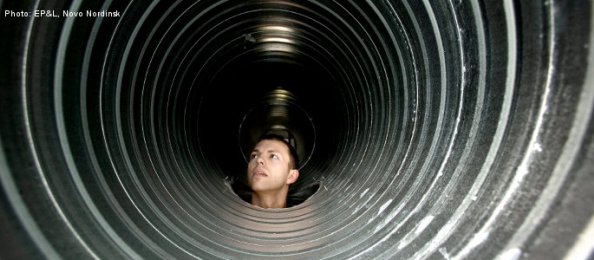Getting to the Bottom Line of Environmental Impacts
Companies depend on services provided by nature, such as fresh water, clean air, healthy biodiversity, and productive land, and their impact on the environment stretches far beyond what goes in and out of a production site. However, the total environmental cost of doing business is not fully accounted for in today’s financial disclosures. Novo Nordisk has looked beyond its own business operations to track the true cost of its environmental impacts.
Novo Nordisk’s business philosophy is one of balancing financial, social, and environmental considerations – also known as “The Triple Bottom Line.” For more than two decades, Novo Nordisk has continued to explore new ways to better understand, manage, and account for its environmental impacts. The company published its first environmental report in 1994, and in 2014 it reached a new milestone when it became the first pharmaceutical company in the world to publish an environmental profit and loss (E P&L) account.

Environmental “track and trace”
An E P&L is like an environmental “track and trace” that places a monetary value on the environmental impacts of an organization and its supply chain. It puts an estimated price on a service that nature provides but for which a market price may not exist, or where the market price does not reflect the full cost. The result is an account that shows how profitability would be affected if the company had to pay for its full impacts.
“Of course it is a difficult task to place a monetary value on services such as fresh water, clean air, biodiversity, and land. However, a monetary value allows for direct comparison between the E P&L account and the regular profit and loss account of a company,” says Anne Gadegaard, Programme Director, Corporate Sustainability at Novo Nordisk.
In the E P&L, the “profit” refers to any company activity that benefits the environment, whereas the “loss” refers to activities that impact the environment negatively. Currently, only some of these costs are borne by the company, such as fees to local governments for water treatment. Companies are not held accountable for the remaining environmental losses, known as external costs or externalities. This could, for example, be the cost of replacing a scarce resource or the associated health costs related to air pollutants.
Comparing water footprints across countries
An E P&L can be a useful tool to identify environmental hotspots in the supply chain and manage risks – for example, when it comes to the company’s water footprint.
A key ingredient in the production of insulin – Novo Nordisk’s main product offering – is glucose, which comes from milled and processed corn. Glucose is purchased by Novo Nordisk in large quantities and relies heavily on agricultural land during the farming of corn, which has a significant water footprint.
Using water data that measures water footprints of crops by country, Novo Nordisk can gain a better understanding of how the sourcing location and regional water scarcity might influence risk in the production of glucose. Novo Nordisk sources its crop inputs primarily from Europe. The chart below shows a comparison of water footprints (cubic meters / tonne) and water cost (EUR / tonne) between a European reference country, the United States, and China (two of the world’s largest corn producers). Per tonne of product, China requires the most water, at 1,073 m3 / t of crop, and the European reference country requires the least, at 643 m3 / t of crop.
However, the picture changes slightly when valuations are applied to the water quantities. The European country requires the least water per tonne of corn produced, but has the highest environmental cost, at € 29. The United States, on the other hand, has a much lower environmental cost of € 19. In the context of Novo Nordisk’s environmental impacts, moving production of glucose from Europe, which has a relatively high water cost, to a country like the United States, which has a lower water cost, might be something to consider when mitigating risk for raw material inputs.
Beyond your own business operations
Performing an E P&L can be a daunting task, as it requires digging deep into the organization to obtain the needed data – but this is only a small part of the equation. The idea behind an E P&L is to also include the environmental costs generated by suppliers and their respective supply chains throughout the world. Where data is not available, environmental costs are derived from using life-cycle assessment modeling.
Novo Nordisk’s E P&L has been built on the work of PUMA, who was the first global corporation to publish a pioneering E P&L back in 2011. The work has been carried out in collaboration with the Danish Ministry of Environment, NIRAS, 2.-0 LCA Consultants as well as Trucost, who also assisted PUMA with their environmental valuation.
The account is based on 2011 performance data and includes Novo Nordisk’s own operations as well as all tiers in the company’s supply chain, from the finished products and services that the company sources (tier 1), to processed raw materials (tier 2), all the way down to the extraction of raw materials or the cultivation of farm crops (tier 3). Environmental indicators cover greenhouse gas emissions, other air pollutants, and water consumption.
The E P&L showed that in 2011 Novo Nordisk was responsible for € 29 million worth of services delivered by nature for operational activities alone. Looking further down the supply chain, the costs increase substantially. Environmental costs across tiers 1, 2, and 3 amounted to € 194 million, or 87 percent of the total cost. Novo Nordisk’s own operations constitute only 13 percent of the total environmental impact, and the main environmental impacts occur in tiers 1 and 3 of the supply chain. Greenhouse gas emissions contribute the most to the total cost (77 percent).
The value of tracking environmental costs
With the E P&L, Novo Nordisk is now one step closer to placing a real price on its environmental costs. But where does the value in this lie, and what will the results be used for? One insight from the E P&L is that the majority of Novo Nordisk’s environmental impacts lie outside the company’s direct control, and therefore can be more difficult to influence. Here, the opportunity to reduce impacts lies in direct engagement with suppliers, and thereby also support the existing supplier strategy.
Although Novo Nordisk continuously works to improve the transparency of its environmental performance reporting, E P&L accounting will not become part of Novo Nordisk’s standard reporting in the near future. Instead, the key strength of the E P&L lies in its ability to map impacts and manage risks.
“The E P&L provides knowledge that will enable us to focus our efforts on the areas of our business with the largest environmental impacts and where there is potential for reductions,” says Anne Gadegaard. “One step could be to develop an environmental balance sheet to ensure that long-term costs of our environmental impact can be included in investment decisions. And by taking a proactive approach, we will strengthen company resilience in the long run.”
Key Facts
| Initiator | Novo Nordinsk |
| Project start | 2011 |
| Status | ongoing |
| Region | worldwide |
| Contact person | Camilla Crone Jensen |
| Awards | - |
Main Issue
| Anti-Corruption | - |
| Business & Peace | - |
| Development | - |
| Environment | X |
| Financial Markets | - |
| Implementing UNGC Principles in your Corporate CSR Management | - |
| Human Rights | - |
| Labour Standards | - |
| Local Networks | - |
Project Type
| Advocacy of global issues | X |
| Business opportunities in low income communities/countries | - |
| Project funding | - |
| Provision of goods | - |
| Provision of services/personal | - |
| Standards and guidelines development | X |
Camilla Crone Jensen works as Project Coordinator, Corporate Sustainability at Novo Nordisk.
Scott Dille is Communications Manager at the Corporate Sustainability department of Novo Nordisk.
Write a comment about this page
Your comments are provided by your own free will and you take sole responsibility for any direct or indirect liability. In order to maintain the highest discussion quality, all comments will be reviewed by our editors. You hereby provide us with an irrevocable, unlimited, and global license for no consideration to use, reuse, delete or publish comments in accordance with our Community Guidelines.


